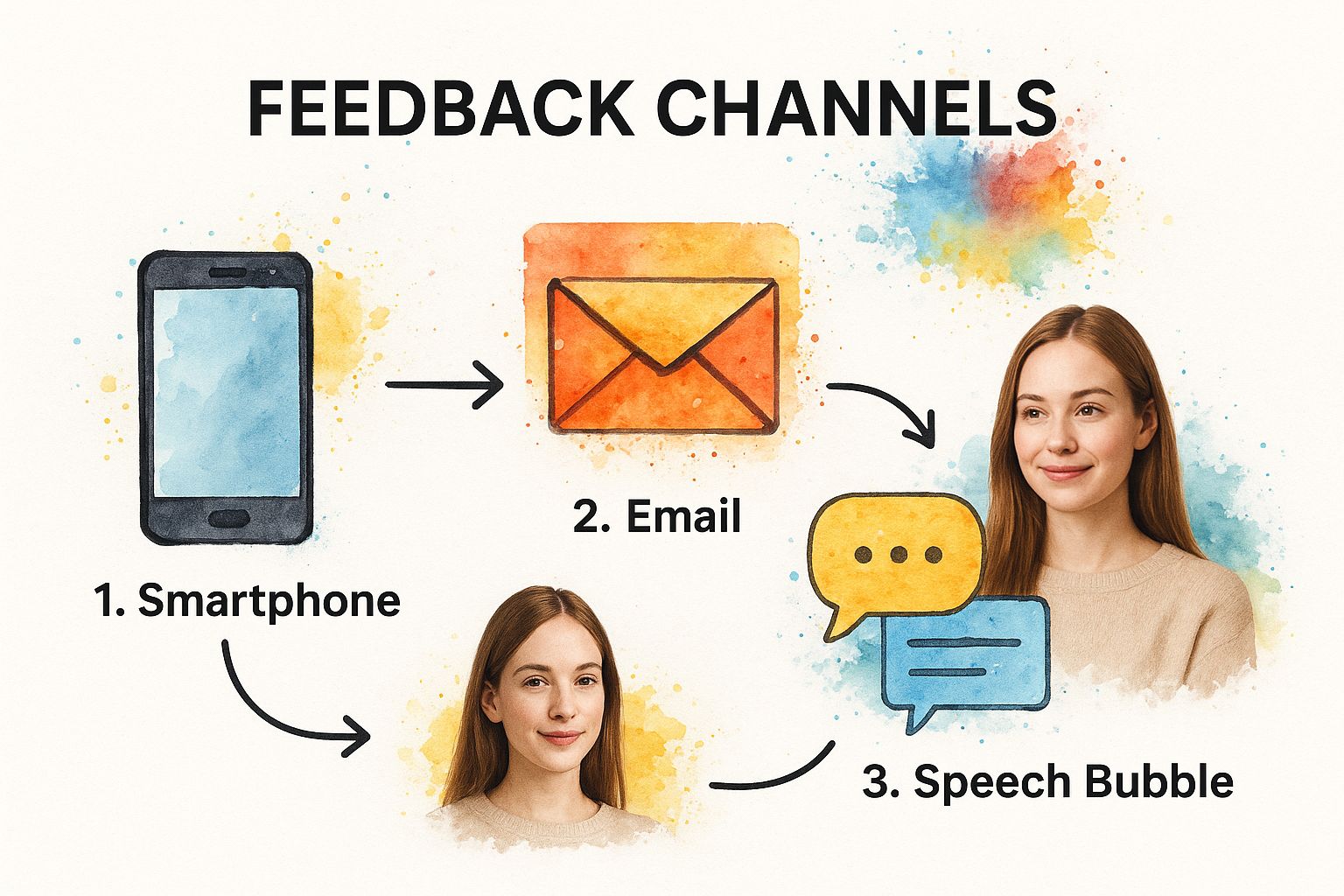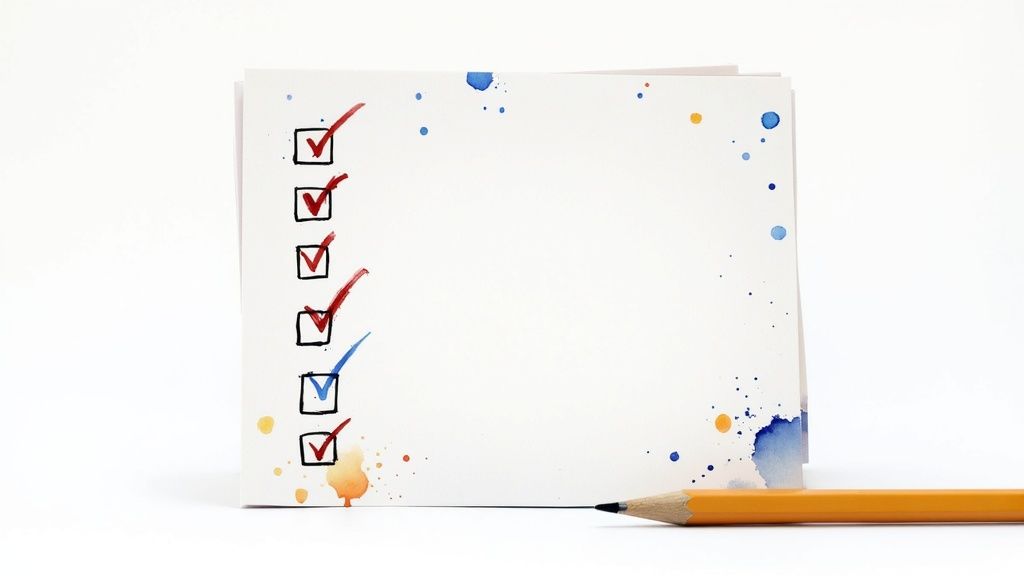How to Get Customer Feedback Without Wasting Your Time
Learn how to get customer feedback effectively. Discover proven methods to gather insights and boost your business growth today.
Posted by
Related reading
Customer Advisory Board: The Founder's Playbook for Avoiding Catastrophic Mistakes
A practical guide to building a customer advisory board that provides honest insights, validates your strategy, and prevents costly product mistakes.
Why Reputation Management Tools Matter More in 2025 Than Ever
Learn how reputation management tools help businesses track reviews, analyze feedback, and protect brand image. A modern guide with AI-driven insights using Backsy.
Sentiment Analysis Isn’t a “Nice-to-Have”. It’s a Lie Detector for Your Product.
Founders love chasing features, but customers speak in emotions. Learn what sentiment analysis really is, how it works, and how it reveals the truth behind your feedback. No fluff.
Let’s be real. Your "customer-centric" roadmap is a fantasy. It’s a list of features you and your VCs think are brilliant, while your actual users are quietly churning because your onboarding is a dumpster fire.
You think you're listening, but you’re just collecting feel-good vanity metrics from polite liars who click "10/10" on your survey and then disappear forever.
This isn’t a guide on how to ask for feedback. It’s a battle plan for how to extract the brutal, profitable truth from the people who actually pay your bills.
Why Most Customer Feedback Is Useless Noise
I’m going to be blunt: you think you're listening to customers, but you're probably just collecting noise. That "suggestion box"? It's a graveyard for good intentions. Those five-star ratings are little more than vanity metrics that make you feel good but teach you absolutely nothing.
The real reason your product isn't growing faster is because you’re deaf to the signal hidden in the customer chaos. You’re asking the wrong questions, in the wrong places, at the wrong times. This is your wake-up call.
The Feel-Good Feedback Trap
Most feedback initiatives are designed to make the company feel good, not to unearth the painful, profitable truths that actually drive progress. You launch a survey asking, "How are we doing?" and celebrate the 8/10 scores, all while ignoring the fact that the question itself is worthless. It's a performance, a ritual to prove you "care" about the customer without ever doing the hard work of truly listening.
This is the fast track to stagnation. You get addicted to hollow praise and become allergic to the criticism that contains your next million-dollar feature. While this guide gets into the nitty-gritty, you could explore these 7 proven strategies to get customer feedback if you enjoy academic exercises. But a strategy without the right mindset is just a different way to fail.
The financial cost of ignoring real, often negative, feedback is catastrophic. It’s not just about hurt feelings; it's about your survival. Data shows that 89% of consumers stop buying from stores after a poor customer service experience. Making things worse, acquiring a new customer costs six to seven times more than keeping one you already have. You can get more insights into the true cost of bad service over on languageio.com.
The Hard Truth: Ignore your customers, and you’ll be lucky to survive the quarter. The market doesn't care about your feelings; it only rewards products that solve real problems.
Stop patting yourself on the back for collecting generic praise. It’s time to get your hands dirty and wade into the messy, unfiltered, and sometimes angry voice of your customer. That's where the roadmap to a product people can't live without is hiding.
Takeaway: Stop chasing vanity metrics and start hunting for painful truths.
Mastering the Art of Surgical Questions
"How can we improve?" is a loser's question. It's lazy, and it gets you lazy, uninspired answers. You might as well ask a Magic 8-Ball to write your product roadmap. If you want feedback that builds your business instead of filling a spreadsheet, get surgical. Cut right to the core of your customer's experience—the good, the bad, and the frustrating.
Forget broad questions. They get you vague compliments ("It's great!") or useless complaints ("Make it better."). Your job is to ask specific, situational questions that force a customer to tell a story. Mastering effective techniques for asking for feedback isn't about being polite; it's about being a detective.
This is why modern feedback collection is about meeting customers where they are, ready to capture their story the moment it happens.

As you can see, feedback isn't a single event. It's a continuous conversation happening across email, chat, and even quick thoughts dictated into a phone. Your job is to be there to listen.
From Lazy Questions to Surgical Questions
The only thing between a useless response and a game-changing insight is how you phrase the question. Lazy questions invite lazy thinking. Surgical questions demand a specific memory, emotion, and story.
Here's how to stop being lazy.
| Lazy Question (Avoid This) | Surgical Question (Ask This) | Why It Works |
|---|---|---|
| Do you like our product? | What's one thing you almost didn't do today because our software made it difficult? | Forces them to recall a specific moment of friction. |
| How can we improve? | If you had a magic wand, what's the one problem you'd solve with our tool tomorrow? | Moves beyond incremental "improvements" to reveal their core desired outcome. |
| Is the price fair? | At what price would our product feel like a steal? At what price would it feel too expensive to consider? | Gets you two concrete data points instead of a simple "yes" or "no." |
| What's your favorite feature? | Walk me through the last time our product saved you a significant amount of time or headache. | Uncovers the "aha!" moment and the real-world value proposition. |
This table isn't a list of questions; it's a shift in mindset. You're moving from a pollster to a detective, looking for clues, not votes.
The Money is in the Story: Your goal isn't a 'yes' or 'no'. Your goal is a story. Customers’ stories are where the money and the future of your product are hidden.
You don't need more data points; you need more narratives. A single, vivid story about a user struggling to find a button is infinitely more valuable than a hundred "8/10" satisfaction scores. That story tells you not just what to fix, but why it matters.
Takeaway: Stop asking for opinions and start digging for stories of pain and delight.
Hunting for Honest Feedback in the Wild
Surveys are for academics and corporate drones. The real gold—that raw, unfiltered truth about your product—isn't on a 1-to-10 scale. It's out there in the wild.
I'm talking about the feedback hiding in plain sight. It’s buried in your support tickets, live chat logs, and especially in those brutally honest reasons people give when they cancel. This is where your customers reveal what they really think when they're frustrated, confused, or walking away for good. Stop collecting feedback and start hunting for it.

Don't wait for feedback to arrive in a neat report. Go find it where it lives.
Your New Hunting Grounds
Your customers are already talking about you. Are you tuned in? Think of these channels not as fires to put out, but as beacons showing you exactly where your product sucks.
Here are the prime spots to listen:
- Support Tickets & Chat Logs: Ground zero. Every support ticket is a story of a user hitting a roadblock. A spike in questions about the same feature isn't a support problem—it’s a product failure.
- Cancellation Reasons: When a customer leaves, that "optional" text box is your most valuable piece of real estate. Their reason for canceling is a direct instruction from the market on what to fix. Ignoring it is malpractice.
- Social Media & Forums: Search Twitter, Reddit, and industry forums for mentions of your brand. Go beyond your name; search for phrases like "anyone else having trouble with [your product]?" or "[your product] vs [competitor]." This is where you find the unvarnished truth.
The goal isn't to be a creepy lurker. It's to be an obsessive detective who understands the most valuable feedback is given when the customer thinks you're not in the room.
Interpreting the Signals
An angry customer firing off a "rage-quit" email isn't an outlier; it’s a symptom of a deeper flaw. A support ticket asking "how do I do X?" for the hundredth time doesn't point to a training gap; it points to a design flaw. Learn to translate raw, emotional signals into concrete product intelligence. This is your early warning system.
This matters because customer expectations are insane. A recent report found that 76% of customers expect to connect with someone immediately. This need for speed makes your support channels a goldmine for real-time feedback. You can see more on how a great customer experience can transform your business in this analysis from Invesp.
Takeaway: Your support desk isn't a cost center. It's your most valuable, real-time source of product intelligence.
Make It Stupidly Simple to Give Feedback
Every extra click you force a customer to make is another excuse for them to bail. Your feedback mechanism shouldn't be a project for them. It needs to be frictionless, immediate, and dead simple.
They just used your product. They have an opinion right now. If you make them navigate a maze of menus, log in again, or fill out a ten-field form, that raw, honest thought is gone. It gets filtered, sanitized, or forgotten. You lost the moment.
The goal isn't a beautiful form; it's a high-conversion feedback system. Customer sees a prompt, says or types their piece, hits submit. That’s it. Anything more is you getting in your own way.
The Anatomy of a Frictionless Feedback Link
Here’s the entire process. Don't screw it up.
- Create product profile
- Send feedback form link
- Ask customer to either type their feedback or speak it out after pressing the mic button
- Click Submit
- Done
This isn’t about fancy design; it's about respecting the user's time and getting the unvarnished truth. To make feedback simple, streamline the submission. You can learn a lot by seeing how to go about creating a customer testimonial form that converts without causing friction.
Founder's Warning: Your job is to remove every barrier between your customer's thought and your database. Every field you add, every click you require, is you actively choosing to hear from fewer, less honest people.
Are you building a pristine, empty art gallery, or a busy street food stall that everyone flocks to? One looks great in a portfolio; the other actually feeds people. Stop designing for portfolios and start designing for action.
Takeaway: Friction filters out raw emotion, leaving you with sanitized, useless data.
Turning Rants and Raves into a Roadmap
So, you've got the feedback. It's a messy pile of support chats, survey responses, and a few spicy churn comments. Congratulations. That was the easy part.
Now what? This is where most founders drop the ball. They let that goldmine rot in a spreadsheet, nod thoughtfully, and go back to building whatever feature they thought was cool yesterday. This is where you get ahead—by doing the work they won't.
Don't just read the feedback; dissect it. This is your system for turning raw customer comments into a product roadmap that moves the needle.

Forget Feature Requests, Hunt for Problems
First mistake everyone makes: creating a list of feature requests. Hard truth: customers are experts at their problems, but they're terrible at designing solutions. When someone asks for a "blue button," they aren't telling you about their favorite color. They're telling you they can't find the damn button.
Your job is to ignore the proposed solution and dig for the underlying problem.
- A customer says, "I wish I could export to CSV." The real problem? They need to get data out of your app to use in another tool.
- They complain, "Your dashboard is confusing." The real problem? The information they need most isn't front-and-center.
- You hear, "This is too expensive." The real problem? They don't see enough value to justify the price.
This isn’t semantics. It’s the difference between building a Frankenstein's monster from random user whims and creating a sleek tool that solves a core problem.
The Art of Tagging and Quantifying Pain
Okay, you need a system. Not some complicated, bureaucratic process. Just a simple way to quantify this qualitative feedback without losing the nuance.
Tag every piece of feedback. But don't tag by feature; tag by the problem or desired outcome. Use tags like #onboarding-friction, #data-export-pain, or #integration-request-hubspot.
As you work through your feedback, clusters will emerge. Suddenly, you have a prioritized list of problems based on how often they come up.
Don’t get fooled by the squeaky wheel. One loud customer is an anecdote. Twenty customers quietly struggling with the same login issue? That's a trend—and a five-alarm fire for your product.
This is how you walk into your next meeting armed with data, not just feelings. You say, "37% of our feedback last month mentioned onboarding friction." That's a statement that demands action. This process is the heart of powerful Voice of Customer analysis, and it’s what separates companies that win from those that guess.
Takeaway: Customer complaints aren't a nuisance; they're your most valuable strategic asset.
Founder FAQs on Customer Feedback
Alright, let's get right to it. You've got questions, and I’ve got the scars from making every mistake in the book. Here are the straight answers. No fluff.
How Often Should I Ask for Customer Feedback?
Forget quarterly schedules. You don’t ask based on a calendar; you ask at the moment of peak emotion.
Did a user just breeze through a key task for the first time? Ask them. Did they just finish a support chat? Ask them. Did they just downgrade or churn? You absolutely better ask them.
This isn't about stale polling that gets polite answers. The goal is continuous, event-triggered feedback that captures the raw truth the second it happens. Ditch the schedule and embed feedback requests into critical moments.
What Is the Biggest Mistake with Negative Feedback?
Getting defensive or ignoring it.
Getting defensive is a rookie move. It poisons the well and guarantees you’ll never hear from that customer again. Ignoring it is pure arrogance. It’s you telling the market your ego matters more than your product.
The biggest mistake is seeing negative feedback as a personal attack instead of what it is: a free consulting session on how to fix your business.
Your angriest customers are often your most passionate. They cared enough to complain. Solve their problem, and you might forge a loyalist for life. Embrace the burn.
Should I Offer Incentives for Feedback?
Tread carefully. Incentives almost always corrupt your data. You’ll attract an army of people who want the $5 gift card, not people with a genuine, burning opinion. Your feedback will end up shallow, polite, and useless.
Instead of paying for opinions, do two things:
- Make it ridiculously easy to give feedback.
- Show them you’re actually listening.
When you ship a feature from someone's suggestion, email them personally. A note saying, "You asked for this, and we built it," is a thousand times more powerful than any Amazon voucher. It builds a tribe of advocates who give you world-class feedback for free.
What Tools Are Essential Besides a Survey Form?
First, ditch the idea of a "survey form" as your primary tool. You need a simple, powerful stack.
Your essentials are a support desk (like Intercom), an analysis tool to make sense of unstructured text and voice (like Backsy.ai), and a dead-simple product management tool (like Trello). The support desk captures the raw rants. The analysis tool finds the profitable patterns. The product tool turns patterns into tasks.
Don't overcomplicate your tech. The tools just facilitate the process. The real work is in the listening and the execution.
Stop drowning in spreadsheets and start building what your customers are begging for—sign up for Backsy.ai and turn messy feedback into your next killer feature.
Article created using Outrank